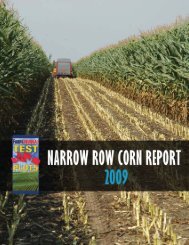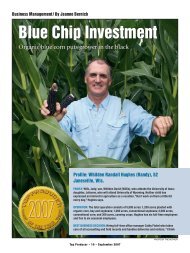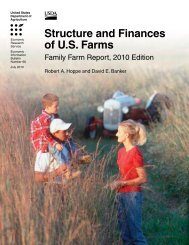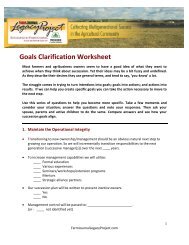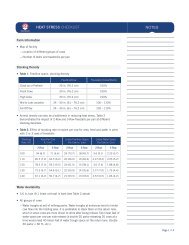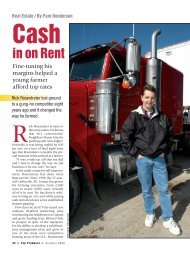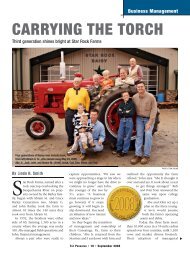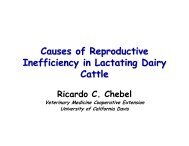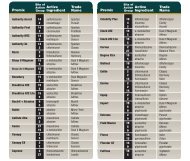24 Economics of Postpartum Uterine Health - AgWeb
24 Economics of Postpartum Uterine Health - AgWeb
24 Economics of Postpartum Uterine Health - AgWeb
You also want an ePaper? Increase the reach of your titles
YUMPU automatically turns print PDFs into web optimized ePapers that Google loves.
Milk production differences from the data set were incorporated into the model as follows: a) datafrom the herd showed that cows with metritis that were culled during the first 30 DIM produced15.1 lbs less milk per day and had a median days-to-exit <strong>of</strong> 10, b) cows with metritis that wereculled during 31 - 60 DIM produced an average <strong>of</strong> 9.1 lbs less milk per day and had a mediandays-to-exit <strong>of</strong> 42, and c) cows with metritis that survived past 60 DIM experienced an average <strong>of</strong>6.2 lb loss per day over the first 110 DIM and then no difference over the rest <strong>of</strong> lactation ascompared to the normal cows. A marginal milk value <strong>of</strong> $0.13 per lb was used, assuming abaseline milk price <strong>of</strong> $18/ cwt and an expected 2.5 lbs <strong>of</strong> marginal milk produced per pound <strong>of</strong>marginal feed consumed. As a consequence, the total estimated milk loss (weighted average)attributable to metritis was $83/ case <strong>of</strong> metritis as shown in Figure 2.Figure 2. Cost Associated with Reduced Milk Production Due to MetritisProduction Losses (Reduced Milk Production)Marginal value <strong>of</strong> lost milk/ metritis case culled (1st 30 DIM) $ (20)% <strong>of</strong> metritis cases culled/ dead 1st 30 DIM 6%Marginal value <strong>of</strong> lost milk/ metritis case culled (31 - 60 DIM) $ (49)% <strong>of</strong> metritis cases culled/ dead 2nd 30 DIM 4%Marginal value <strong>of</strong> lost milk/ cow with metritis retained past 60 DIM $ (89)% <strong>of</strong> metritis cases retained past 60 DIM 90%Total milk loss/ case (weighted avg) $ (83)The metritis-related cost associated with reduced reproductive performance wasestimated using a modified version <strong>of</strong> Overton’s previously described economic model (Overton2001, Overton and Galvao 2004, Overton 2006a, Overton 2006b). The reproductive performancedata was fit in the model in order to generate a simulated Kaplan-Meier survival plot thatapproximated the original study data and to estimate the 21-day pregnancy rate for eachsubgroup by modifying the insemination and conception risk for each 21-day period. Animals thatfailed to conceive within 12-21day breeding cycles were assumed culled as non-pregnant cows.In addition, variable culling risks were applied within each 21-day period to mimic the dairy’s realresults.A total <strong>of</strong> 73% <strong>of</strong> normal cows that calved became pregnant and survived for the entire lactationcompared to only 59% for the cows with metritis. The modeled survival plot reveals anattributable culling risk <strong>of</strong> 8% due to metritis-associated infertility. Combining this 8% risk with theattributable culling risk during the first 60 DIM (5.3%) yields a total that approximates the 14%from the actual data (73% – 59%). Average and median days open were 16 and 33 days longer,respectively, for the metritis group. The predicted 21-d pregnancy rate was 17.5% for the normalcows and 13% for the cows experiencing metritis. As a consequence <strong>of</strong> the combined effects <strong>of</strong>excess culling and the costs <strong>of</strong> extra insemination and breeding program efforts, the predictedmonetary loss was approximately $121 per cow in the breeding pool, or $109 per case <strong>of</strong> metritis,once the total was adjusted to account for the earlier culls. These values were calculated using areplacement cost <strong>of</strong> $2,200, herd level 305ME <strong>of</strong> 25,000, a milk price <strong>of</strong> $18, salvage value <strong>of</strong>$621, and an interest rate <strong>of</strong> 8% as inputs in the reproduction model.26
Figure 3. Time-to-Event Plot for Normal vs. Metritis Cows100%90%80%% <strong>of</strong> Cows Remaining Open70%60%50%40%30%20%Normal CowsMedian DOPN = 133Pregnancy Rate = 17.5%Metritis CowsMedian DOPN = 166Pregnancy Rate = 13%10%0%507192113134155176197218239260281302DIMThe final area <strong>of</strong> consideration is the direct treatment cost associated with metritis. Themodel considers two different antibiotic choices for systemic therapy, cefti<strong>of</strong>ur (Excenel®RTU,Pfizer) and ampicillin (Polyflex®, Fort Dodge), and assumes no therapeutic advantage for one vs.the other. We assumed that one would use the Excenel as per label (1 mg/ lb (2 ml/ 100 lbs) IMor SQ once daily for 5 days) and that Polyflex would also be used once daily for 5 days (5 mg/ lbor 2 ml/ 100 lbs <strong>of</strong> rehydrated product). The cost per 100 ml bottle was assumed to be $58 forExcenel and $29 for Polyflex based on current market prices for each. Excenel does not requirea milk withdrawal and as long as no other therapy that requires a withdrawal is used, the treatedcow does not have to enter the hospital pen. Polyflex, on the other hand, has a withdrawal <strong>of</strong> 48hours following the last treatment. The model does not consider any supportive therapy orescape therapeutic options since these are assumed to be the same for each drug.The model allows the user to toggle between the drugs and to also select how thediscarded milk is handled if Polyflex is used. If Excenel is used, the estimated cost is $81. IfPolyflex is used and the milk is fed as waste milk, the cost is $53 after accounting for theopportunity cost <strong>of</strong> the discarded milk that is utilized as calf feed. On the other hand, if Polyflex isused and the milk is discarded, the cost is $109, accounting for the lost opportunity cost <strong>of</strong> thediscarded milk.By adding each <strong>of</strong> the components <strong>of</strong> the model together, the total estimated cost <strong>of</strong> acase <strong>of</strong> metritis may be determined. The total cost due to culling in the first 60 DIM as aconsequence <strong>of</strong> metritis is $85 per case, the total milk loss due to metritis is $83 per case and thelosses due to reproductive issues is $109 per case. The actual treatment cost varies from $53 to$109 depending upon drug used and the utilization <strong>of</strong> any withheld milk. Using theaforementioned definition <strong>of</strong> metritis and actual data derived from the farm, the total estimate cost27
per case <strong>of</strong> metritis is $358 if Excenel is used, $329 if Polyflex is used and the milk is used t<strong>of</strong>eed calves, or $386 if Polyflex is used but the withheld milk is discarded.Discussion and ConclusionThe total estimated cost <strong>of</strong> metritis in this model is significantly higher than the previousestimate cited ($106 by Bartlett et al, 1986). However, a few major differences in herdperformance and approach used in the models should be recognized between the two estimates.In the Bartlett paper, which relied on monthly DHIA data, no impact on milk production due tometritis was found. In the current paper, significant losses were identified that were very similarto those reported by Deluyker et al, 1991. Both <strong>of</strong> these studies used daily milk weights andperhaps there was a greater ability to measure differences with more frequent (and presumablymore sensitive) measurements. Other possibilities to explain the discrepancies include a differinglevel <strong>of</strong> milk production for the herds investigated and potentially, a difference in the definition formetritis used between the studies. If disease misclassification occurs, the tendency would be tobias the results toward finding no difference due to the inclusion <strong>of</strong> normal cows in the abnormalgroup and vice versa.Bartlett et al reported a very low culling risk overall and an attributable culling risk due to metritis<strong>of</strong> only 6.1%. In this paper, the attributable culling risk was 5.3% within the first 60 DIM alone,and when combined with the breeding period, the total attributable culling risk was 14%. Thedifference in attributable culling risk alone accounts for approximately $100 <strong>of</strong> the large differencebetween estimates.Reproductive losses were handled in different ways as well. In Bartlett et al, the total cost due toreproductive failure was estimated to be only $18.89, based primarily on the value <strong>of</strong> differencesin days open. In the current study, the approach used to estimate the reproductive losses usedan existing reproductive model to account for changes in expected milk production as aconsequence <strong>of</strong> change in reproductive performance, a difference in number <strong>of</strong> inseminations,and differences in culling due primarily to reproductive failure. Using commonly cited values forthe cost <strong>of</strong> a day open, the current data set would have a reproductive cost <strong>of</strong> approximately $48if only average days open was the criteria used, but this approach underestimates the true cost <strong>of</strong>the reduced reproductive performance.It is difficult to address the differences in treatment costs between the two studies. Exacttreatment used was not reported by Bartlett et al but they did state that the medication cost pertreated cow was only $2.74 as compared to at least $53 in the current study. Milk that waswithheld as a consequence <strong>of</strong> treatment was estimated to cost the dairy $23.85 based on theirestimate that approximately half <strong>of</strong> the milk that was assumed to have been withheld was fed tocalves. The price <strong>of</strong> milk and level <strong>of</strong> production is likely very different between the two datasets.In summary, the total cost <strong>of</strong> metritis in this large herd was estimated to be approximately $358per diagnosed case, despite aggressive systemic antibiotic therapy. The magnitude <strong>of</strong> thisestimate may surprise some, but the reality is that metritis is an expensive disease problem. Ifthe results <strong>of</strong> this model are applied to a herd <strong>of</strong> 1,000 milking cows, and the lactational incidencefor metritis is 22% as found with this modeled herd, the total cost would be approximately$79,000 per year using the previously mentioned assumptions. Of course, individual herd costsare likely to vary depending upon treatments utilized, definition <strong>of</strong> metritis and detection methodsused, cow comfort potential, season, nutritional support, etc. Regardless <strong>of</strong> the exact cost, theauthors <strong>of</strong> this paper suggest that there may be significant financial returns to made by improvingtransition management in an effort to reduce the risk <strong>of</strong> developing metritis.28





